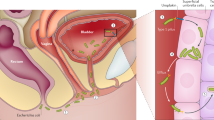Abstract
In the past year, interest has heightened in the potential for probiotics to prevent urinary tract infection (UTI). Mainly, this has been due to concerns about antibiotic resistance and recognition of the scientific efficacy of probiotics. The critical factors in any successful application of probiotics to patient care are the scientific basis for selecting probiotic strains and clinical verification that they are effective against the recurrence of UTI. Three strains—Lactobacillus rhamnosus GR-1 and Lactobacillus fermentum B-54 and RC-14—have been shown to colonize the vagina and act as a barrier to the ascension of uropathogens into the bladder. Their ability to produce growth and adhesion antagonists against urogenital pathogens is clinically important, because these appear to be important mechanisms of action. Probiotic therapy has been shown to be safe, but too few reliable products are on the market, and none are yet available for use against UTI. Given the right strains and delivery system, probiotic therapy could provide the first new UTI-prevention system in 40 years, and may help in the management of recurrent UTI.
Similar content being viewed by others
References and Recommended Reading
Larkin M: Probiotics strain for credibility. The Lancet 1999, 354:1884.
Reid G: The scientific basis for probiotic strains of Lactobacillus. Appl Environ Microbiol 1999, 65:3763–3766. This mini-review establishes a set of scientifically based criteria upon which to select probiotic lactobacilli, and illustrates that only a handful of organisms have “passed the litmus test” of having supportive peer-reviewed publications on mechanisms of action and clinical effectiveness.
Gupta K, Scholes D, Stamm WE: Increasing prevalence of antimicrobial resistance among uropathogens causing acute uncomplicated cystitis in women. JAMA 1999, 281:736–738. This confirms our findings about drug-resistant uropathogens see reference 4) and demonstrates the major increase in resistance of common uropathogens to trimethoprim-sulfamethoxazole.
Reid G, Seidenfeld A: Drug resistance amongst uropathogens isolated from women in a suburban population: laboratory findings over 7 years. Can J Urol 1997, 4:432–437.
Charteris WP, Kelly PM, Morelli L, Collins JK: Antibiotic susceptibility of potentially probiotic Lactobacillus species. J Food Protection 1998, 61:1636–1643.
Patton DL, Kidder GG, Sweeney YC, et al.: Effects of multiple applications of benzalkonium chloride and nonoxynol-9 on the vaginal epithelium in the pigtailed macaque (Macaca nemestrina). Am J Obstet Gynecol 1999, 180:1080–1087.
Watts DH, Rabe L, Krohn MA, et al.: The effects of three nonoxynol-9 preparations on vaginal flora and epithelium. J Infect Dis 1999, 180:426–437.
Erikson B: A randomized, open, parallel-group study on the preventive effect of an estradiol-releasing vaginal ring (Estring) on recurrent urinary tract infections in postmenopausal women. Am J Obstet Gynecol 1999, 180:1072–1079.
Habash M, van der Mei HC, Reid G, Busscher HJ: The effect of water, ascorbic acid and cranberry derived supplementation on human urine and uropathogen adhesion to silicone rubber. Can J Microbiol 1999, 45:691–694.
Harkins KJ: What’s the use of cranberry juice? A review. Age Ageing 2000, 29:9–12.
Girodon F, Galan P, Monget AL, et al.: Impact of trace elements and vitamin supplementation on immunity and infections in institutionalized elderly patients: a randomized controlled trial. MIN.VIT.AOX. geriatric network. Arch Int Med 1999, 159:748–754.
Chambers ST, Peddie BA, Randall K, Lever M: Inhibitors of bacterial growth in urine: what is the role of betaines? Int J Antimicrob Agents 1999, 11:293–296.
Reid G, Bruce AW, Soboh F, Mittelman M: Effect of nutrient composition on the in vitro growth of urogenital Lactobacillus and uropathogens. Can J Microbiol 1998, 44:1–6.
Ocana VS, Pesce de Ruiz Holgado AA, Nader-Macias ME: Selection of vaginal H2O2-generating Lactobacillus species for probiotic use. Curr Microbiol 1999, 38:279–284.
Prasad J: Selection of characterisation of Lactobacillus and Bifidobacterium strains for use as probiotics. Int Dairy J 1998, 8:993–1002.
Mack DR, Michail S, Wei S, et al.: 1999. Probiotics inhibit enteropathogenic E. coli adherence in vitro by inducing intestinal mucin gene expression. Am J Physiol 1999, 276:G941-G950.
Tachikawa T, Seo G, Nakazawa M, et al.: Estimation of probiotics by infection model of infant rabbit with enterohemorrhagic Escherichia coli 0157:H7 [Japanese]. Kansenshogaku Zasshi 1998, 72:1300–1305.
Tannock GW: The bowel microflora: an important source of urinary tract pathogens. World J Urol 1999, 17:339–344. This is an excellent perspective on the source of uropathogens, the intestine, and how different factors can influence their emergence to cause urinary tract infections (UTIs). It seems critical that we begin to understand the whole process of infection-starting at the source-rather than just focus on the virulence of pathogens on bladder and kidney epithelia. This review is part of an excellent issue of World Journal of Urology completely devoted to UTI.
Palaszynski S, Pinkner J, Leath S, et al.: Systemic immunization with conserved pilus-associated adhesins protects against mucosal infections. Dev Biol Stand 1998, 92:117–122.
Salminen S: Demonstration of safety of probiotics—a review. Int J Food Microbiol 1998, 44:93–106.
Naidu AS, Biblack WR, Clemens RA: Probiotic spectra of lactic acid bacteria (LAB). Crit Rev Food Sci Nutr 1999, 39:13–126. This paper reviews 143 human clinical trials of probiotics and documents the degree to which these therapies are safe.
Hamilton-Miller JM, Shah S, Winkler JT: Public health issues arising from microbiological and labelling quality of foods and supplements containing probiotic microorganisms. Public Health Nutr 1999, 2:223–229. This papers adds to the body of information about this subject from several other papers published during the past 10 years. The consensus is that too few probiotic products contain the material that is on the label or the viable count that is stated, and that the proof of the “healthcare” attributes or certain products are mostly unproven. The potential pathogen Enterococcus faecium was isolated from nine of 52 products studied.
Author information
Authors and Affiliations
Rights and permissions
About this article
Cite this article
Reid, G. Probiotic therapy and functional foods for prevention of urinary tract infections: State of the art and science. Curr Infect Dis Rep 2, 518–522 (2000). https://doi.org/10.1007/s11908-000-0055-3
Issue Date:
DOI: https://doi.org/10.1007/s11908-000-0055-3




